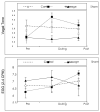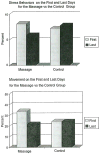Preterm infant massage therapy research: a review
- PMID: 20137814
- PMCID: PMC2844909
- DOI: 10.1016/j.infbeh.2009.12.004
Preterm infant massage therapy research: a review
Abstract
In this paper, preterm infant massage therapy studies are reviewed. Massage therapy has led to weight gain in preterm infants when moderate pressure massage was provided. In studies on passive movement of the limbs, preterm infants also gained significantly more weight, and their bone density also increased. Research on ways of delivering the massage is also explored including using mothers versus therapists and the added effects of using oils. The use of mothers as therapists was effective in at least one study. The use of oils including coconut oil and safflower oil enhanced the average weight gain, and the transcutaneous absorption of oil also increased triglycerides. In addition, the use of synthetic oil increased vagal activity, which may indirectly contribute to weight gain. The weight gain was associated with shorter hospital stays and, thereby, significant hospital cost savings. Despite these benefits, preterm infant massage is only practiced in 38% of neonatal intensive care units. This may relate to the underlying mechanisms not being well understood. The increases noted in vagal activity, gastric motility, insulin and IGF-1 levels following moderate pressure massage are potential underlying mechanisms. However, those variables combined do not explain all of the variance in weight gain, highlighting the need for additional mechanism studies.
Copyright 2010 Elsevier Inc. All rights reserved.
Figures





References
-
- Backstrom M, Kuusela A, Maki R. Metabolic bone disease of prematurity. Annuals of Medicine. 1996;28:275–82. - PubMed
-
- Chang HY, Mashimo H, Goyal RK. Musings on the wanderer: what's new in our understanding of vago-vagal reflex? IV. Current concepts of vagal efferent projections to the gut. American Journal of Physiology Gastrointestinal and Liver Physiology. 2003;284:G357–66. - PubMed
-
- Cifra HL, Sancho MN. Massage therapy with preterm infants and children with chronic illnesses. In: Field T, editor. Touch and Massage Therapy in Early Development. Johnson & Johnson Pediatric Institute, L.L.C.; 2004.
-
- Colonna F, Pahor T, de Vonderweid U, Tonini G, Radillo L. Serum insulin-like growth factor-I (IGF-I) and IGF binding protein-3 (IGFBP-3) in growing preterm infants on enteral nutrition. Journal of Pediatric Endocrinology and Metabolism. 1996;9:483–489. - PubMed
-
- De-Roiste A, Bushnell IWR. Tactile stimulation: short and long-term benefits for preterm infants. British Journal of Developmental Psychology. 1996;41:41–53.
Publication types
MeSH terms
Grants and funding
LinkOut - more resources
Full Text Sources
Medical
Miscellaneous

